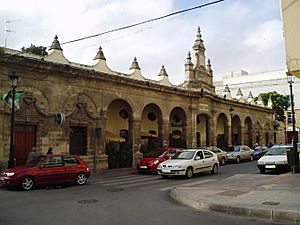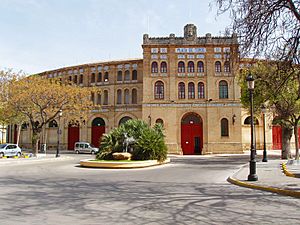El Puerto de Santa María facts for kids
Quick facts for kids
El Puerto de Santa María
Port Saint Mary
|
|||
|---|---|---|---|
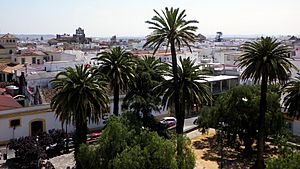 |
|||
|
|||
| Nickname(s):
La ciudad de los 100 palacios (The city of the 100 palaces)
|
|||
| Motto(s):
Puerto de Menesteo
|
|||
| Country | Spain | ||
| Autonomous Community | Andalusia | ||
| Province | Cádiz | ||
| Government | |||
| • Type | Ayuntamiento | ||
| Area | |||
| • Total | 159.34 km2 (61.52 sq mi) | ||
| Elevation | 0 m (0 ft) | ||
| Population
(2018)
|
|||
| • Total | 88,364 | ||
| • Density | 554.563/km2 (1,436.31/sq mi) | ||
| Demonym(s) | Portuense | ||
| Time zone | CET (GMT +1) | ||
| • Summer (DST) | CEST (GMT +2) | ||
| Post code |
11500
|
||
| Area code(s) | +34956 | ||
El Puerto de Santa María, often called El Puerto, is a cool city in Spain. It's right by the Guadalete River in the province of Cádiz, in the region of Andalusia. In 2016, about 88,184 people lived here.
The city's name means "the Port of Saint Mary". It's also known as "Port Saint Mary" in English. El Puerto is located about 10 kilometers (6 miles) northeast of Cádiz, across the beautiful Bay of Cádiz.
History of El Puerto de Santa María
Ancient Legends and Early Settlements
Long, long ago, a Greek hero named Menestheus came here after the Trojan War. He sailed through the Strait of Gibraltar and found the Guadalete River. His group settled here and called the place 'Menestheus's Port'. They even built an oracle (a place to get advice from the gods) dedicated to him.
In 711 AD, a group called the Moors from North Africa took over southern Spain. They renamed the port Alcante or Alcanatif, which means "Port of Salt". This name came from the old salt-making industry started by the Phoenicians and Romans.
The Reconquest and a New Name
In 1260, Alfonso X of Castile, a Spanish king, took the city back from the Moors. He gave it a new name: Santa María del Puerto. The king also organized the land and gave the city special rights. This meant it could use "El" before its name, becoming "El Puerto de Santa María".
From then on, El Puerto became a very important town in the Kingdom of Seville during the late Middle Ages. By the 15th century, the population was still quite small, with fewer than 2,000 people.
Columbus and World Maps
Did you know that Christopher Columbus visited El Puerto in 1480? He got a lot of encouragement for his big travel plans here. His pilot, Juan de la Cosa, who lived in El Puerto, drew the very first world map that included the coast of the New World in 1500!
El Puerto was also home to many rich cargadores. These were merchants who managed Spain's trade with the Americas. During the 16th and 17th centuries, it was a key winter port for the royal galley ships.
Modern History and French Influence
In the 1800s, the city became the main base for the French Army during the Peninsular War. This was when Joseph Bonaparte ruled Spain (from 1801 to 1812).
Today, El Puerto is full of history, with many museums and old buildings. It's also easy to visit other famous cities like Seville and Cádiz from here.
Geography and Natural Beauty
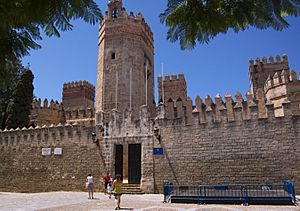
El Puerto de Santa María is on the Atlantic coast, right in the Bay of Cádiz. It's close to other towns like Jerez de la Frontera, Rota, Puerto Real, and Cádiz. The city is famous for its delicious sherry wine and its beautiful beaches.
Popular Beaches and the Port
The beaches are a big reason why tourists love El Puerto. Some well-known ones include Vistahermosa, Valdelagrana, and La Puntilla. There's also a large port called Puerto Sherry.
Nature Reserve and Wildlife
A big part of the land around El Puerto is protected as the Bay of Cádiz Nature Reserve. This area includes a pine forest, which is one of three important natural environments here. You might spot an endangered species of chameleon, along with many other reptiles and birds. Even Egyptian mongoose can be seen in this area! There are also two other amazing natural parks nearby: the Sierra de Grazalema and El Coto Doñana.
Economy and Local Industries
The most important way El Puerto makes money is through tourism. People love coming here for the beaches and for the exciting bullfighting events held in the arena during summer. The city also welcomes many motorcyclists when the Jerez Motorcycle Grand Prix takes place.
There are many shops and businesses in the city center and surrounding areas. El Puerto also has a very strong wine industry, especially known for its sherry.
Culture and Celebrations
El Puerto de Santa María is known for its lively festivals and traditions. Here are some of the main ones:
- Spring Carnival: This fun event happens in Cádiz and nearby areas. People dress up in costumes and enjoy parades in the streets. It usually ends 47 days before Easter.
- Semana Santa (Holy Week): The week before Easter Sunday is a special time. There are daily parades with long lines of people called penitents and big crowds. It's a very traditional and moving experience.
- Campeonato de España (Motorbike Races): In April, there's a weekend of music and dance for the World Championships of Motorcycling. It's a big party for motorbike fans!
- Feria del Vino Fino (Spring Fair): This is El Puerto de Santa María's main local festival, usually held in the middle of May. It's a week of celebration, often linked to May 1st.
- Romería del Rocío: This is a huge, festive pilgrimage where up to a million people travel to the village of Rocío in Huelva. It usually happens around the third week of May.
- Hogueras de San Juan: On June 23rd, people celebrate Midsummer with bonfires and fireworks on the beaches across Cádiz.
- Dia de la Virgen del Carmen: On July 16th, people honor the Virgen Del Carmen, who is very popular with fishermen. Her statue is carried from the church, taken out to sea on a fishing boat, and then paraded around town. It's a day of general festivities.
- Virgen de los Milagros: The city's patron saint is La Virgen de los Milagros (Virgin of the Miracles). On September 8th, her statue is carried from the main church and paraded through the streets over a carpet of flowers. It's another local holiday.
Main Sights to Explore
El Puerto de Santa María has many amazing historical buildings and places to visit:
- Bullring of El Puerto: Built in 1880, this impressive bullring can hold 15,000 spectators.
- Iglesia Mayor Prioral: This beautiful church dates back to 1486.
- Castle of San Marcos: This fortified church was built on top of an old 10th-century Islamic mosque. King Alfonso X of Castile ordered its construction in 1364, even using parts of an ancient Roman building.
- Monastery of the Victory: This monastery was built in the early 16th century by the Dukes of Medinaceli.
- Antigua Lonja: Located in the port, this "Ancient Loggia" building dates back to the 18th century.
- Museo Arqueológico Municipal: This is the city's archaeological museum, where you can learn about its ancient past.
There are also many other historic churches, convents, palaces, and fountains to discover throughout the city!
Events and Traditions
Bullfighting is still a popular event in El Puerto. It's enjoyed during the Feria season in August and also during the Feria de la Primavera (Spring Fair) in early May.
International Connections
El Puerto de Santa María has special connections with other cities around the world. These are called twin towns or sister cities:
 La Güera, Western Sahara
La Güera, Western Sahara Coral Gables, Florida, United States
Coral Gables, Florida, United States Texcoco, Mexico
Texcoco, Mexico Brighton, United Kingdom
Brighton, United Kingdom Calp, Spain
Calp, Spain
Famous People from El Puerto
Many talented people have come from El Puerto de Santa María, including:
- Pedro Muñoz Seca, a famous playwright.
- Rafael Alberti, a well-known poet from the Spanish Generation of 1927.
- Juan Modesto, a Republican general.
- Juan Antonio de Vizarrón y Eguiarreta, who was a viceroy and archbishop.
- Joaquín Sánchez Rodríguez, a football player.
- José Manuel Pinto, another football player.
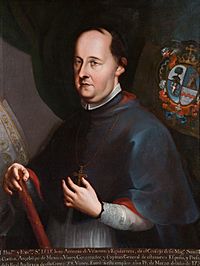
Images for kids
-
Entrance, "Feria de Primavera y Fiesta del Vino Fino" (Festival of Spring and Feast of Vino Fino
See also
 In Spanish: El Puerto de Santa María para niños
In Spanish: El Puerto de Santa María para niños





